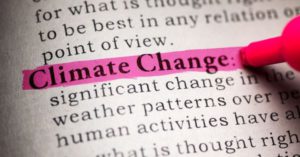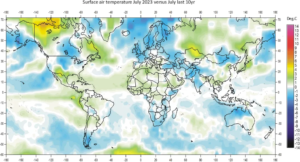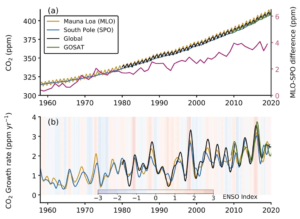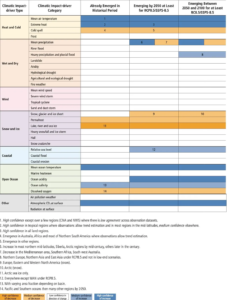The imaginary “climate crisis” is a product of climate activists and click-bait media
The UN’s Intergovernmental Panel on Climate Change (IPCC) reports don’t define what a “climate crisis” is. The crisis that supposedly requires society to achieve zero carbon emissions or, at least, “net zero.”

On the contrary, the IPCC’s Assessment Report (AR6) published in 2021 points out that corporate media’s opinion of climate change has moved away from a neutral position by adopting and promoting terms like “climate crisis,” “global heating” and “climate emergency.”
Such a statement by the IPCC should leave no doubt that the concept of an ongoing “climate crisis” is a joint product of climate activists and the click-hungry media, lacking a solid scientific basis, Aivar Usk writes.
So, what does science tell us about the climate? Usk details his research into climate models, catastrophe scenarios and the imaginary climate crisis while giving us a reality check of what climate records do show, without the media hype. For example, “July 2023, dubbed the ‘Earth’s hottest month on record’, may have had almost the same number of warmer and cooler regions in the world in comparison with the time one decade earlier,” he writes.
Climate Models, Catastrophe Scenarios and the Imaginary Climate Crisis
By Aivar Usk
The term “climate crisis” is nowadays a frequent feature in politicians’ speeches and in the media, the “mitigation” of which is said to require society to achieve zero carbon emissions or at least Net Zero.
However, we do not find a definition of this arguably existential threat to humanity in the expected concentrate of current climate science, i.e. the reports of the UN’s Intergovernmental Panel on Climate Change (IPCC). On the contrary, the Assessment Report AR6 (from 2021), prepared by the Scientific Basis for Climate Change Working Group (WG1), a 2,409-page volume entitled Climate Change 2021. The Physical Science Basis, points out that the media’s treatment of climate change has moved away from the neutral position, adopting and promoting terms like “climate crisis”, “global heating” and “climate emergency.” Such a statement by the IPCC should leave no doubt that the concept of ongoing “climate crisis” is a joint product of climate activists and the click-hungry media, lacking a solid scientific basis.
The term is also absent from the European Union’s Climate Change Act of 2021, even though the European Parliament already declared a climate and environmental emergency in November 2019.
A certain amount of warming of our planet’s climate can indeed be detected if one chooses a suitable starting point in the time series of recent temperatures, for example, by comparing the present state to the times at the end of the Little Ice Age around 1850, or 1880, or even the cooler period between 1944 and 1976. The reasons of cooling in the mid-20th century have not yet been fully explained, considering that the concentration of carbon dioxide in the atmosphere had already been increasing by that time, as were the anthropogenic CO2 emissions. The period suggests that there is no strict correlation between the increase in CO2 and temperature, and hence no causality, as has already been demonstrated in palaeoclimatology.
The estimates of temperature increase would be even somewhat milder if the starting point of the time series were to be set at the intense 1877/1878 episode of El Niño, the tropical weather phenomenon that caused “the year without a winter” of elevated global temperatures.
However, looking back over the millennia, the hypothesis of an unprecedented warming of our times is rebutted by the Medieval and Roman warm periods, not to mention the Holocene Climate Optimum of around 6,000 years ago.
Periods of rapid warming comparable to the present have also occurred in the past, some of them classified as Dansgaard-Oeschger events of unknown cause. Despite the decades-long bias in climate science cited by many scientists, studying the links between future climate trends and human impacts remains necessary, as well as attempts to model the future.
Research of the coming years will show whether the warming recorded in 2023 was caused by a convergence of three factors, as many scientists have assumed: the proximity of the peak of the 25th cycle of solar activity, the strong tropical weather event El Niño, and the known record amount of water vapour injected into the stratosphere by the underwater volcanic eruption of Hunga Tonga-Hunga Ha’apai.
The impact of anthropogenic CO2 has been small and continuous, and could not have caused such rapid warming. An undisputed fact seems to be that the Earth has been significantly warmer than today for most of the latest 500 million years, probably warmer than reasonable projections for 2100, and it has not triggered any irreversible tipping points in the climate system.
Condensing temperature differences relative to a reference period all over the planet into a single artificial value called the global mean surface temperature anomaly, and then tracking it within a hundredth of a degree has been criticised by many scientists due to uncertainties in measurement and homogenisation. While there may be sufficient amounts of measurement data available from different regions of the planet today, many of them are arguably biased by the urban heat island effect of global impact, and there are some creative elements in adjusting the past temperature record.
When we look beyond that single number, the picture across all climate zones may be nowhere near as scary as the catastrophe announcements in the media suggest. For instance, data collected by NASA’s AIRS satellites and published monthly on the website of Dr. Ole Humlum, professor emeritus of geography at the University of Oslo, show that July 2023, dubbed the “Earth’s hottest month on record,” may have had almost the same number of warmer and cooler regions in the world in comparison with the time one decade earlier. Old newspapers do not allow us to forget the extreme weather conditions of almost a century ago, which make the past year’s summer pale in comparison.

Climate Modellers’ Club Gravitating Towards Heat
In the IPCC Third Assessment Report (TAR), WG1 concluded that “the climate system is a coupled non-linear chaotic system, and therefore the long-term prediction of future climate states is not possible, the focus must be upon the prediction of the probability distribution of the system’s future possible states by the generation of ensembles of model solutions.”
In essence, scientists in different countries create their own climate models – the Atmosphere-Ocean Coupled General Circulation Model AOGCM, or GCM – to calculate projections of temperature, precipitation, and other climate parameters, the outputs of which are then jointly compared in the hope that the average of all the representatives of the model family can provide reliable information. To this end, the Coupled Model Intercomparison Project (CMIP) has been launched, with the results of the most recently compared model family CMIP6 providing input to the IPCC’s recent AR6 report.
Although the horizontal resolution of climate models has so far been modest – simulations have typically used a 100 x 100 km grid – due to a large number of parameters, dozens of vertical layers, and complex algorithms, the model calculation results have taken a long time to be produced, requiring months for runs.
Scientists in different countries have widely differing views on the magnitude of the additional greenhouse effect due to carbon dioxide added to the atmosphere by human activities. The Equilibrium Climate Sensitivity (ECS), the temperature rise in degrees Celsius in a new equilibrium after the concentration of CO2 in the atmosphere doubles, is a key parameter for models.
Depending on the origin of the model, it may vary in magnitude by several times, not by mere decimal places. There seems to be no consensus on this point: while the Russian climate scientists who created the INM-CM4-8 model are convinced that a proper ECS is 1.8°C, the Chinese model CAMS-CSM1-0 uses 2.3°C, the Norwegian NorESM2-LM 2.5°C, Japan’s MIROC6 uses 2.6 ºC, and the US NASA GISS-E2-1-G uses 2.7 ºC, while the US NCAR model CESM2 uses an ECS of 5.2 ºC, the UK HadGEM3-GC31-LL uses 5.5 ºC, and the Canadian model CanESM5 uses 5.6 ºC (McKitrick & Christy, 2020).
In light of such divergent results, even the IPCC’s expectations of climate models as predictors have somewhat diminished after decades of model development – there has been no convergence of ECS values.
Already in 2017, Dr. John R. Christy, a climate scientist at the University of Alabama in the US, demonstrated to the US House Committee on Science, Space, and Technology that there is significant bias amongst the vast majority of the representatives of the previous model family CMIP5, as well as on the average, towards excessive warming relative to observational data.
“As such, the average of the models is considered to be untruthful in representing the recent decades of climate variation and change, and thus would be inappropriate for use in predicting future changes in the climate or for related policy decisions,” he concluded.
The warming bias of the current CMIP6 family of models has also been addressed by the modellers themselves, who have called some of the temperatures predicted by the models “insanely scary and wrong.”
An article by Dr. Zeke Hausfather et al. in the world’s leading science journal Nature in May 2022 warned that some of the latest climate models are “too hot” and are predicting climate warming in response to CO2 emissions larger than supported by other evidence. It was also noted that already published research findings claiming that the impacts of climate change will be “worse than we thought” are often attributable to the CMIP6’s “hot” models.
The inability to generate credible future projections can be seen as evidence that modellers lack a correct and complete understanding of the nature of climate processes. In particular, they are criticised for their inadequate treatment of the effects of the Sun, clouds and volcanic activity.
Scientists who feed the crisis narrative generally avoid direct debate, but in a few public debates that have been held, scientists from the climate realist camp have presented more convincing arguments (2018, 2023). Dissenting voices are mostly suppressed or ignored, with activists consistently trying to label them as “paid by the fossil fuel industry” or even “flat-Earthers,” not qualifying as a climate scientist being a minor charge. Surely, it can’t be that a physics Nobel laureate might be able to understand the nuances of climate science and express credible critical opinions on the matter – for, after all, he is not a certified climate scientist?
Dr. Roy W. Spencer, a US climate scientist with a background working at NASA, compared the predictions of the latest generation of climate models with the observational record to date and found that over the period of 1979-2022, the global warming predicted in average by the CMIP6 family of models exceeded the meteorological balloon record by 43% and the satellite record by 75%.
In addition to the large differences in temperature projections between the results of the models developed by climate scientists in different countries, the models assumed that there are no natural drivers of long-term changes in the climate system other than anthropogenic greenhouse gases. These facts are not mentioned when climate model projections are used as a basis of policy making.
After a brief review of other relevant drivers, Dr. Spencer summarises the article by stating: “Given these uncertainties, policymakers should proceed cautiously and not allow themselves to be influenced by exaggerated claims based on demonstrably faulty climate models.”
Scenarists and Directors
One of the inputs for climate models is the scenarios of the time series of future human carbon emissions, which allow a choice to be made between assuming a low, medium or increasing fossil fuel consumption future during model runs. The four emission scenarios used so far in the previous generation were generically referred to as Representative Concentration Pathway (RCP); they were distinguished by the radiative forcing predicted for the year 2100, shown after the abbreviations. For example, the most extreme scenario, RCP8.5, which assumes the highest carbon dioxide emissions, if realised by 2100, would lead to an increase in the greenhouse effect by 8.5 W/m2 compared to the year 1750, due to an increase in the proportion of greenhouse gases in the atmosphere, with possible accompanying phenomena. The lowest scenario, RCP2.6, would lead to an increase of only 2.6 W/m2.
In 2021, the IPCC estimated the magnitude of the greenhouse effect in the atmosphere to be 159 W/m2, with water vapour as the most abundant greenhouse gas accounting for 75% of it. Remarkably, IPCC is fully aware of the fact that the El Niño Southern Oscillation (“ENSO”) strong warm phase events can double or even triple the otherwise modest monthly CO2 growth rates which tend to follow the ENSO-related temporary temperature rise. Reading in the AR6 WG1 report that the fraction of anthropogenic CO2 emissions that have accumulated in the atmosphere has remained near constant over the past six decades does not trigger imaginary sirens of a human-caused climate crisis either.

The five emission scenarios of the current generation are referred to as Shared Socioeconomic Pathway (SSP); preceding the numerical value of radiative forcing, their abbreviation is followed by a number indicating the severity from one to five, e.g. SSP5-8.5, reflective of fossil fuel-based development, replacing a previous scenario RCP8.5. The implausibility of both of these scenarios has already been pointed out by the IPCC in its AR6 report, which foresees their use in studies as an extreme case that still cannot be ruled out rather than as a “business-as-usual” reference baseline. Experts have calculated that in order to achieve the corresponding impacts, at least one new coal-fired power plant would have to be commissioned somewhere in the world every single day until 2100. However, articles with alarming research results based on the RCP8.5 scenario continue to be published at a rate of around 25 per day. At the same time, Table 12.12 in Section 12.5.2 of the IPCC AR6 WG1 report leaves no doubt whatsoever that there is low confidence in the occurrence of most of the extreme weather events such as floods, tornadoes, droughts, wildfires, etc. as emerging climate change signal by the end of the century in 2100 – even under the extreme CO2 emission scenarios RCP8.5/SSP5-8.5. Perhaps it is needless to remind that such weather events are already predominantly attributed to anthropogenic global warming in the media without following the attribution analysis process foreseen by the IPCC.

A new set of emission scenarios is also planned to be developed for the CMIP7 family of models in preparation for the forthcoming IPCC AR7 report, for which the new extreme emission scenario will have a lower radiative forcing than RCP8.5, closer to 7 W/m2, as can be expected based on the minutes of the first ScenarioMIP workshop.
This is a step away from providing tools for forecasting regular catastrophes; nevertheless, according to US climate scientist Roger Pielke Jr, a plausible extreme scenario should have an even lower impact, as the world is already on a lower trajectory of emissions than RCP4.5.
That would result in projections of a moderate and safe warming of the climate, which would not justify the need to intervene in people’s way of life and the economy with radical net-zero emission policies, as Dr. Nicola Scafetta, a climate scientist from Italy, concludes in his article.
Although the IPCC does not explicitly recommend it, the recipe for cooking up a “climate crisis” has so far been to take one of the “hot” climate models, use it in conjunction with an extreme emissions scenario and feed the results painting an “insanely scary” future to some climate activist journalist or an insufficiently informed politician with moderate analytical skills.
Dr. Pielke has recently published a thought-provoking blog article identifying some of the directors of the RCP8.5 popularisation process which provides a few hints about their possible agenda.
There is no doubt that resource efficiency and a reasonably paced circular economy are essential for the balanced development of society, but the costs of implementing climate legislation and pursuing “climate goals” remain, in the light of the above, more likely than not a waste of resources.
Although numerous research results point to natural variability as a dominating driver of climate change, the politically motivated science community supporting the anthropogenic climate crisis narrative is still strong, for the reasons explained by US physicist Dr. William Happer in a recent documentary.
As pointed out by environmental economics professor Björn Lomborg, the expected costs of achieving “net zero” could exceed the benefits by more than seven times by 2100, with proposed policy measures comparable to imposing a three-mile-per-hour speed limit on traffic worldwide as an attempt to avoid a total of over one million road deaths per year. The costs of climate change adaptation measures could also be inflated when future climate impact estimates are based on “hot” models and extreme emission scenarios.
It feels fitting to conclude with a quote from one of the official reviewers of the IPCC’s third assessment report TAR – Estonian-born professor from the University of Toronto, Olev Träss, said in an interview with an Estonian newspaper Postimees:
“The question is if we should reduce carbon dioxide and allocate big money on it – I would not do that. I am quite convinced, and I feel that I am on the right track with it, that the impact of carbon dioxide is quite minute. The whole scientific community that we’re having this debate with, even at the University of Toronto, is largely of the same opinion – we’re convinced that this green agenda is really a fraud.”
Looking at the growing number of signatures of publicly dissenting scientists under the World Climate Declaration, it appears substantiated that any state that is secular by the constitution should distance itself from the climate crisis cult, stop listening to scientists selectively and reassess the need for climate targets, abandoning utopian and costly climate action except adaptation, and leaving the humanity on the path of decarbonisation spurred by advances in science and technology, paced by depoliticised market pull.
yogaesoteric
May 13, 2024
